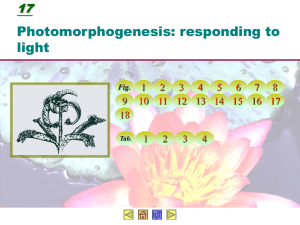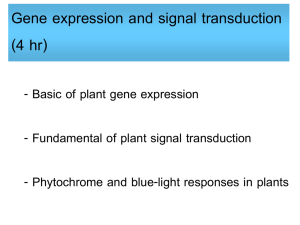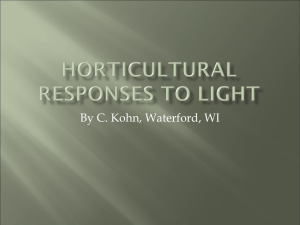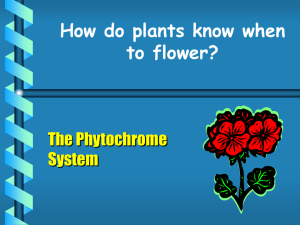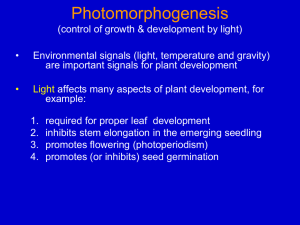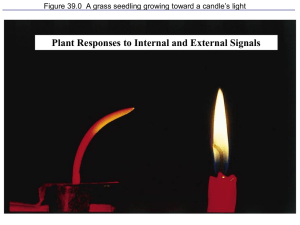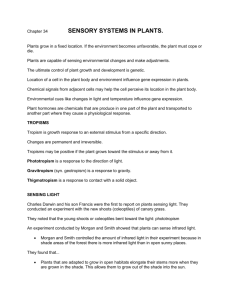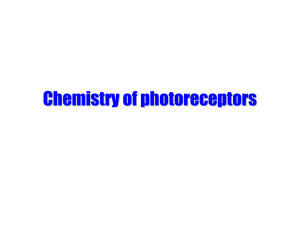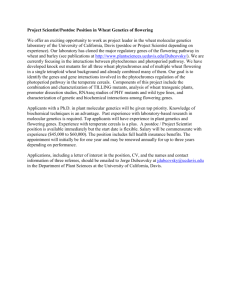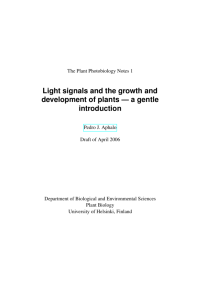Phytochromes and light signal perception by plants—an emerging
advertisement
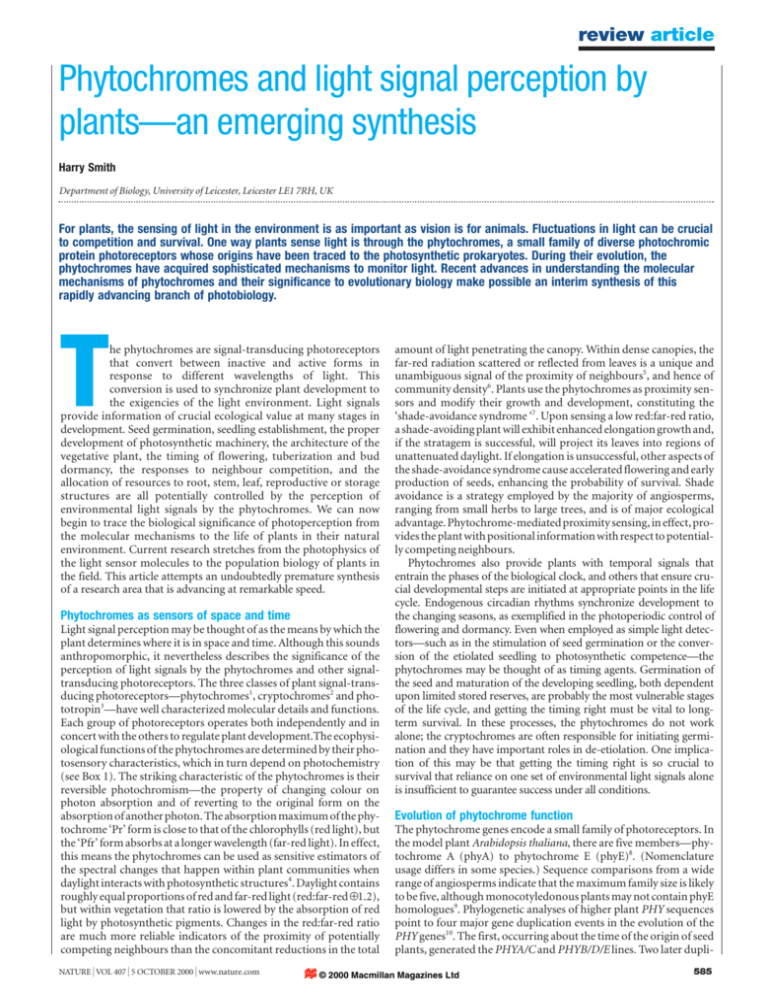
review article Phytochromes and light signal perception by plants—an emerging synthesis Harry Smith Department of Biology, University of Leicester, Leicester LE1 7RH, UK For plants, the sensing of light in the environment is as important as vision is for animals. Fluctuations in light can be crucial to competition and survival. One way plants sense light is through the phytochromes, a small family of diverse photochromic protein photoreceptors whose origins have been traced to the photosynthetic prokaryotes. During their evolution, the phytochromes have acquired sophisticated mechanisms to monitor light. Recent advances in understanding the molecular mechanisms of phytochromes and their significance to evolutionary biology make possible an interim synthesis of this rapidly advancing branch of photobiology. T he phytochromes are signal-transducing photoreceptors that convert between inactive and active forms in response to different wavelengths of light. This conversion is used to synchronize plant development to the exigencies of the light environment. Light signals provide information of crucial ecological value at many stages in development. Seed germination, seedling establishment, the proper development of photosynthetic machinery, the architecture of the vegetative plant, the timing of flowering, tuberization and bud dormancy, the responses to neighbour competition, and the allocation of resources to root, stem, leaf, reproductive or storage structures are all potentially controlled by the perception of environmental light signals by the phytochromes. We can now begin to trace the biological significance of photoperception from the molecular mechanisms to the life of plants in their natural environment. Current research stretches from the photophysics of the light sensor molecules to the population biology of plants in the field. This article attempts an undoubtedly premature synthesis of a research area that is advancing at remarkable speed. Phytochromes as sensors of space and time Light signal perception may be thought of as the means by which the plant determines where it is in space and time. Although this sounds anthropomorphic, it nevertheless describes the significance of the perception of light signals by the phytochromes and other signaltransducing photoreceptors. The three classes of plant signal-transducing photoreceptors—phytochromes1, cryptochromes2 and phototropin3—have well characterized molecular details and functions. Each group of photoreceptors operates both independently and in concert with the others to regulate plant development.The ecophysiological functions of the phytochromes are determined by their photosensory characteristics, which in turn depend on photochemistry (see Box 1). The striking characteristic of the phytochromes is their reversible photochromism—the property of changing colour on photon absorption and of reverting to the original form on the absorption of another photon. The absorption maximum of the phytochrome ‘Pr’ form is close to that of the chlorophylls (red light), but the ‘Pfr’ form absorbs at a longer wavelength (far-red light). In effect, this means the phytochromes can be used as sensitive estimators of the spectral changes that happen within plant communities when daylight interacts with photosynthetic structures4. Daylight contains roughly equal proportions of red and far-red light (red:far-red ≈ 1.2), but within vegetation that ratio is lowered by the absorption of red light by photosynthetic pigments. Changes in the red:far-red ratio are much more reliable indicators of the proximity of potentially competing neighbours than the concomitant reductions in the total NATURE | VOL 407 | 5 OCTOBER 2000 | www.nature.com amount of light penetrating the canopy. Within dense canopies, the far-red radiation scattered or reflected from leaves is a unique and unambiguous signal of the proximity of neighbours5, and hence of community density6. Plants use the phytochromes as proximity sensors and modify their growth and development, constituting the ‘shade-avoidance syndrome ‘7. Upon sensing a low red:far-red ratio, a shade-avoiding plant will exhibit enhanced elongation growth and, if the stratagem is successful, will project its leaves into regions of unattenuated daylight. If elongation is unsuccessful, other aspects of the shade-avoidance syndrome cause accelerated flowering and early production of seeds, enhancing the probability of survival. Shade avoidance is a strategy employed by the majority of angiosperms, ranging from small herbs to large trees, and is of major ecological advantage. Phytochrome-mediated proximity sensing, in effect, provides the plant with positional information with respect to potentially competing neighbours. Phytochromes also provide plants with temporal signals that entrain the phases of the biological clock, and others that ensure crucial developmental steps are initiated at appropriate points in the life cycle. Endogenous circadian rhythms synchronize development to the changing seasons, as exemplified in the photoperiodic control of flowering and dormancy. Even when employed as simple light detectors—such as in the stimulation of seed germination or the conversion of the etiolated seedling to photosynthetic competence—the phytochromes may be thought of as timing agents. Germination of the seed and maturation of the developing seedling, both dependent upon limited stored reserves, are probably the most vulnerable stages of the life cycle, and getting the timing right must be vital to longterm survival. In these processes, the phytochromes do not work alone; the cryptochromes are often responsible for initiating germination and they have important roles in de-etiolation. One implication of this may be that getting the timing right is so crucial to survival that reliance on one set of environmental light signals alone is insufficient to guarantee success under all conditions. Evolution of phytochrome function The phytochrome genes encode a small family of photoreceptors. In the model plant Arabidopsis thaliana, there are five members—phytochrome A (phyA) to phytochrome E (phyE)8. (Nomenclature usage differs in some species.) Sequence comparisons from a wide range of angiosperms indicate that the maximum family size is likely to be five, although monocotyledonous plants may not contain phyE homologues9. Phylogenetic analyses of higher plant PHY sequences point to four major gene duplication events in the evolution of the PHY genes10. The first, occurring about the time of the origin of seed plants, generated the PHYA/C and PHYB/D/E lines. Two later dupli- © 2000 Macmillan Magazines Ltd 585 review article Box 1 Sensors of environmental light signals Phytochromes are photochromic photoreceptors The central hypothesis of phytochrome action, proposed almost 50 years ago from pioneering investigations by S. Hendricks, H. Borthwick and colleagues, is that the photoreceptors exist in two, photoconvertible forms, Pr and Pfr. Pr is biologically inactive and upon absorption of red photons is converted to Pfr, the active form. Pfr is converted back to Pr by far-red photons. Biological action stems from Pfr. The photoconversions involve a number of intermediate forms in both directions, and the establishment of an equilibrium between Pr and Pfr takes several minutes even at daylight irradiance levels. The absorption spectra of the phytochromes peak at about 665 nm and 730 nm. The absorption bands overlap, so radiation below about 700 nm activates photoconversion of both Pr and Pfr. Thus, in daylight for example, a photoequlibrium of about 60% Pfr/P (where P = total phytochrome) is established—in canopy shade or crowded communities, the photoequilibrium can be as low as Pfr/P = 0.1. This is the basis of the shade-avoidance syndrome. Phytochromobilin H N H N O S N H N O COOH COOH Cys Apoprotein Pr Absorption Spectra Pfr 400 500 600 700 nm Daylight Spectra Open cations, at about the time of the origin of the flowering plants, separated PHYA from PHYC and PHYB/D from PHYE. PHYB and PHYD diverged much more recently. Evolution within the phytochrome family appears to be faster than other plant nuclear genes11. These evolutionary pathways created a family of proteins that detect identical environmental signals but employ those signals in different functions. PHY-like genes occur not only in all green plants, including gymnosperms, ferns, mosses and algae, but also in cyanobacteria12-14 and even in certain other bacteria15,16. The chromophore-bearing domain is conserved between plants and bacteria, and in most cases the bacterial chromophore is a bilin, as it is in plants. In the purple photosynthetic bacterium Rhodospirillum centenum, the bilin attachment site is unoccupied, but the domain is linked to a photoactive yellow protein (PYP) domain carrying phydroxycinnamic acid as a chromophore15. In the non-photosynthetic bacteria Deinococcus radiodurans and Pseudomonas aeruginosa, the chromophore is a bilin, but its attachment is through a Schiff’s base to a histidine, rather than a thio-ether linkage to the cysteine attachment site present in plant phytochromes16. Thus, although the chromophore is not always a bilin or attached to the same amino-acid residue, the conserved region seems to be involved in photoperception in all organisms investigated. This might provide a clue to the evolutionary origin of the conserved chromophore-bearing domain of the phytochromes. In the mosses and ferns, the phytochromes seem to be particularly involved in phototropism17, a function mediated exclusively by the blue-light absorbing phototropin in the angiosperms3. Indeed, in the fern Adiantum, a gene has been characterized that encodes both a typical phytochrome and a protein with sequence similarity to NPH1 (the Arabidopsis phototropin)18. The evolution of a chimaeric photoreceptor bearing properties of both red/far-red and blue light absorption poses the question whether such molecules exist and function elsewhere. Another chimaeric phytochrome gene has been identified in the moss Ceratodon19, encoding a protein kinase carboxy-terminal segment, but whether this is functional has not been determined. In the angiosperms, the phytochromes have acquired new functions and fine-tuned existing functions during evolution (Box 2). The individual family members have both distinct and overlapping physiological functions20, and even antagonistic interactions have been reported21. It is important to realize that phytochromes operate quantitatively to limit the rates of ongoing processes, rather than qualitatively to select between potential developmental fates. In other words, phytochromes are more like speed limits than signposts on the highways of development. Phytochrome mechanisms Canopy Phytochrome absorption spectra drawn from data supplied by J. C. Lagarias. Chromophore is a linear tetrapyrrole The chromophore is an open-chain linear tetrapyrrole—known as phytochromobilin—and is closely related to phycocyanobilin, the chromophore of the abundant algal pigment C-phycocyanin. In higher plant phytochromes, the chromophore is covalently attached to the protein through a thio-ether link at a cysteine positioned at amino-acid residue 374 (numbering for phyA). Assembly of apoproteins and chromophore occurs spontaneously, presumably involving inherent chromophore lyase activity in the phytochrome apoproteins. This property has allowed the construction of recombinant phytochrome adducts with either phytochromobilin or phycocyanobilin—both are spectrally photoreversible and active when transgenically expressed in planta. 586 Most investigators propose that the phytochromes act through the selective regulation of gene expression. The expression of several genes, largely those encoding enzymes and other components of the photosynthetic machinery, is regulated by light, often by phytochrome22,23. On the other hand, some phytochrome-mediated responses are best explained by assuming rapid alterations in interor intra-cellular ion balances24. Some growth responses also occur quite rapidly (within minutes25,26), posing the question whether transduction chains involving the regulation of nuclear gene expression would be sufficiently quick. In certain algae, mosses and ferns, at least part of the cellular phytochrome is cytoplasmic and dichroically organized with respect to either the cell membrane or the cytoskeleton27. These phenomena imply a cytoplasmic growth-homeostasis mechanism in which the photoreceptor continuously monitors the light environment and mediates rapid changes in ionic concentrations within cell compartments that modulate extension growth. Therefore, individual phytochromes may have at least two, separate mechanisms of action: one that results in selective expression of target genes and another that rapidly and reversibly operates to modulate cellular ionic balances. © 2000 Macmillan Magazines Ltd NATURE | VOL 407 | 5 OCTOBER 2000 | www.nature.com review article Box 2 Molecular, physiological and ecological functions 1 Amino acid sequence C-374 Chromophore 1210 COOH NH2 Structural domains 1 Amino terminal 673 674 Carboxy terminal 1210 Chromophore lyase Spectral integrity Pr–Pfr conformational changes Dimerization Sequence homology with Synechocystis PHY Photosensory specificity Regulatory activity Redrawn and simplified with permission from ref. 69. Physiological and ecological functions It is convenient to think of the phytochromes as being ‘singleinput/multiple-output’ sensory systems, in which a common signal evokes a range of biological responses. Phytochromes are capable of regulating almost all phases of plant development, but the control is conditional or facultative, rather than obligatory. Germination. Many small seeds with low levels of stored reserves require light signals for germination, whereas most larger seeds do not. For some buried seeds, the sensitivity is spectacular, sometimes requiring only milliseconds of light exposure for full response. NATURE | VOL 407 | 5 OCTOBER 2000 | www.nature.com phyB Ge phyA rmination E stablishment F lowering ? chitecture Ar The phytochromes are chromoproteins with a relative molecular mass of about 120,000–126,000. They are encoded by five PHY genes (named PHYA–PHYE) in the model crucifer Arabidopsis thaliana (family size and nomenclature may vary in other species). Isolation of mis-sense mutations and transgenic expression of mutant phytochromes enabled certain molecular functions to be attributed to ‘domains’. Thus, the molecule possesses two structural domains: a globular N-terminal half and a more linear C-terminal half. Chromophore lyase and spectral integrity are associated with the chromophore-bearing N-terminal domain. The phytochromes are dimers in solution, with putative dimerization sites located within the C-terminal segment. Evidence from photophysical analysis indicates that conversion from Pr to Pfr causes an ‘opening’ of the protein conformation in relation to the chromophore, perhaps facilitating the interaction of Pfr with its primary reaction partners. Transgenic expression of constructs with the N- and C-terminal domains exchanged between phyA and phyB show the photosensory specificity is in the N-terminal half, and the regulatory specificity is in the C-terminal half. Alignment with gene sequences from cyanobacteria reveals common ancestry and provokes interesting questions on the original adaptive value of the phytochromes. phyD phyE ? Seedling establishment. This is the set of processes through which a germinated seedling becomes photoautotrophic. Phytochromes cooperate with cryptochromes to regulate de-etiolation, leaf expansion and chloroplast maturation. Architecture of the mature plant. The size and disposition of internodes and leaves, the balance between main stem and lateral branches, the angles of petioles and leaf laminae are acutely sensitive to the radiation environment. Induction of flowering and dormancy. The photoperiodic perception of day length, involving interaction with the biological clock, is necessary (in some plants) for the induction of flowering and bud dormancy. Towards a life-history of phytochrome functions Mutant studies70 and the use of transgenic plants expressing individual phytochrome genes71 mean that we can reliably allocate physiological and ecological function to four of the five phytochromes, at least for Arabidopsis thaliana. Mutants null for phytochromes A, B, D and E have been isolated and their physiological responses extensively characterized. The overall picture is that phyB has a role at all stages of the life cycle, whereas phyA, phyD and phyE exert their principal functions at selected stages. © 2000 Macmillan Magazines Ltd 587 review article Phytochrome action requires two partial processes at the level of the photoreceptor molecule: perception of the light signal and its transduction to a biochemical signal. Domain-swapping experiments in which the amino-terminal and the carboxy-terminal halves of phyA and phyB were exchanged verify the molecular specificity of these sensory and regulatory activities with the photosensory functions of phyA and phyB present in the respective N-terminal half of the molecule, and a common regulatory site present in the C-terminal portion28. Thus, phytochromes exhibit dual molecular functions: a sensory function responsible for detecting relevant light signals, and a regulatory function in which the perceived information is transferred to downstream transduction pathways. Interestingly, the sensory and regulatory domains appear to be evolving at different rates, with the C-terminal domain evolving at least twice as fast as the N-terminal domain11. Current ideas on the primary mechanism of phytochrome regulation of gene expression centre on two contrasting, but not necessarily incompatible, hypotheses (Fig. 1). In one, phytochromes are considered to be kinases that act on multiple substrates thereby regulating the expression of genes differentially. The other is that phytochromes have one or more specific reaction partners that direct signal transduction towards the selective control of gene expression. Phytochromes as kinases. The possibility that plant phytochromes are kinases has long been controversial29. In the prokaryotes, the PHY genes encode the sensory halves of two-component response systems, and significant sequence similarity exists between the C-terminal domains of eukaryotic phytochromes and bacterial response elements30. The bacteriophytochrome (named DrBphP) in D. radiodurans functions as a light-regulated histidine kinase, controlling the synthesis of the carotenoid pigment deinoxanthin, which apparently serves to protect the organism from bright light16. Immediately downstream of BphP is a coding region for a response regulator protein (BphR), which acts as the phosphate acceptor for the kinase activity of DrBphP. The closest sequence relative of BphR is the corresponding response regulator component of the Synechocistis phytochrome (Rcp1), the proposed phosphate acceptor for the cyanobacterial phytochrome, Cph1 (ref. 14). The kinase activity of plant phytochromes was confirmed by the construction of recombinant phytochromes using PHY genes from Arabidopsis and the green alga Mougeotia. After assembly with chromophore, the holoproteins possessed serine/threonine kinase activity, rather than the expected histidine kinase activity31. The recombinant phytochromes autophosphorylated and, in a clinching experiment, transferred phosphate to recombinant Rcp1. Support for the phytochrome-as-kinase concept comes from the detection, by yeast two-hybrid screening, of a phytochrome kinase substrate (PKS1), a cytosolic protein that accepts a phosphate from phyA32. Phosphorylation is on a serine, and to a lower extent on a threonine residue and is regulated by light, being about twofold higher with Pfr than Pr. Phosphorylation also occurs in vivo in a phytochrome-dependent manner. Transgenic expression shows that PKS1 is a negative regulator of photomorphogenesis specific to phyB. Other possible substrates of phytochrome kinase activity are the cryptochrome photoreceptors33. The situation is even more complex as phyA also interacts with a nucleoside diphosphate kinase (NDPK2), found in both the cytoplasm and the nucleus34. The kinase activity of NDPK2 is increased about twofold when bound to recombinant phyA in the Pfr form, but an in vitro activation of NDPK1 by red or far-red radiation has not been reported. The regulation of gene expression could, in principle, emanate from the kinase activity of phytochrome per se, and/or activation of NDPK1. Primary interaction partners. Yeast two-hybrid screens have revealed several potential primary reaction partners for phyA and phyB. Whether all of these will have important roles is in the balance, but the most conclusive evidence yet is for PIF3 (phytochrome interacting factor 3; ref. 35). PIF3 was found in a two-hybrid assay using the Cterminal portion of phyA as the bait. It interacts equally with the C 588 terminus of phyA and phyB, but preferentially with the intact phyB protein. Interaction with intact phyB is light dependent36. PIF3 is a basic helix—loop—helix (bHLH) protein with a PAS motif and locates to the nucleus in transfection experiments. PIF3 binds poorly to mis-sense phyB molecules mutated in the putative C-terminal regulatory region, and furthermore, transgenic expression of sense and anti-sense constructs of PIF3 perturbs the response to light. Serendipitously, PIF3 was simultaneously identified as a transduction chain component by a screen for gain-of-function mutants under red radiation treatment37. These data strongly support the hypothesis that PIF3 is a functional primary reaction partner for phyB. Recent data on the phyB/PIF3 interaction point to a remarkable shortcut mechanism in which light signals are targeted directly through phyB to PIF3 bound to promoter elements of some lightregulated genes38. Promoter analysis has identified a number of cisacting light-responsive elements (LREs) and some DNA-binding Sequestration? Cytoplasmic action Pr Red Pfr Far-red PKS1 PKS1 Kinase cascade PKS1 Kinase substrate NDPK1 Inactive Pr Red Active Pfr Far-red Cytoplasm Nuclear translocation Pr Red Far-red Pfr Nucleus NDPK1 Kinase cascade PIF3 bHLH transcription factor PIF3 Phytochrome-regulated genes Figure 1 Diagram of phytochrome action. Phytochromes undergo photoconversion from the biologically inactive form (Pr) to the active form (Pfr). Pr and Pfr are shown as dimers in the cell. The Pr–Pfr conversions are initiated by photon absorption in the chromophore leading to steric changes, causing the holoprotein to `open up' and facilitating interaction with putative reaction partners. The diagram shows the three major theories for the subsequent actions of the phytochromes, although Pfr may regulate growth and development by other processes. Pink area: both Pr and Pfr interact with PKS1, the phytochrome kinase substrate, in the cytosol. This may be the first step in a kinase cascade (orange area) culminating in action within the cytoplasm. Alternatively, interaction with PKS1 may result in sequestration of phytochrome in the cytosol, preventing translocation to the nucleus. Yellow area: Pfr interacts with NDPK1, a nucleoside diphosphate kinase, which is located both in the cytoplasm and the nucleus. Again, this interaction may initiate a kinase cascade (orange) leading to ultimate action within the cytoplasm and/or nucleus. Green area: Pfr translocates to the nucleus and Pr is translocated back to the cytoplasm. The weights of the arrow emphasize the differential rates of import and export. Within the nucleus, Pfr binds with PIF3 (phytochrome interacting factor 3) which is located exclusively within the nucleus. PIF3 is a basic helix–loop–helix transcription factor that binds to the promoters of selected light-regulated genes in combination with Pfr and initiates or enhances transcription. © 2000 Macmillan Magazines Ltd NATURE | VOL 407 | 5 OCTOBER 2000 | www.nature.com review article proteins that may interact with LREs and thus regulate transcription39. One of these promoter elements, a G-box motif, is the core PIF3 target element38. So, PIF3 associates with elements characteristically found in the promoters of certain genes whose expression is regulated by phytochrome. Moreover, phyB in the Pfr form complexes with PIF3 bound to its DNA target site. PIF3 anti-sense plants displayed reduced levels of phytochrome-regulated gene expression for some, but not all, light-regulated genes. These data provide a picture of the direct transfer of light signals to the promoters of a subset of light-regulated genes. Light-regulated nuclear translocation The phytochrome apoproteins are synthesized within the cytosol and assemble autocatalytically with the plastid-derived chromophore. For years phytochromes were considered to be entirely cytosolic, but now there is strong evidence for photoactivated nuclear translocation of phytochromes40. Both phyA and phyB tagged with green fluorescent protein (GFP) show light-activated import into the nuclei of tobacco41 and Arabidopsis42 cells. Import of phyB occurs only in the Pfr form and is slow, requiring several hours for full mobilization. Phytochrome A, either as PfrA, or as PrA that has been photoconverted through PfrA and back again, moves more rapidly (about 15min). The photobiological criteria are satisfied as phyB transport is activated by red radiation and inhibited by far-red radiation, whereas the transport of phyA is maximal under continuous far-red radiation. These facts provide a framework for understanding the phytochrome regulation of gene expression through the translocation of Pfr into the nucleus, interaction with primary reaction partners (such as PIF3) and direct regulation of the promoters of light-regulated genes. Alternatively, nuclear localization places Pfr in the appropriate cellular compartment for its activity as a protein kinase to operate on factors regulating transcription. It is worth considering whether all the correct questions are being asked. The data on nuclear transport and gene expression described come from experiments on dark-grown seedlings given light treatments. Seedlings treated in this way are induced to undergo a one-off transition, which will not be repeated, and which under natural conditions prepares the plant for life in a photic environment. The dynamics of nuclear translocation may only be mechanistically significant during this initial transition. Thereafter, except for newly synthesized molecules, the phytochrome may remain principally within the nucleus during daylight hours, where interaction with light-responsive genes can occur rapidly. Superimposed on this there will be daily gross movements of phytochrome into and out of the nucleus conditioned by light and dark periods, and indeed it has already been reported that nuclear translocation of phyB is under circadian control43. Such control may position phyB in the nucleus, where it can rapidly control development in response to signals from neighbouring plants, and so provide the sensitivity to environmental fluctuations that is characteristic of shade avoidance in plant communities. Phenotypic plasticity and evolutionary significance Phytochrome-mediated shade avoidance is a model for the functional significance of physiological adaptation to environmental signals, giving ecologists and evolutionary biologists a handle on the evolution of phenotypic plasticity. Phenotypic plasticity—the expression of variability in the phenotype of individuals of identical genotype— and its fitness consequences are crucial concerns for evolutionary biologists44-46. There is controversy regarding the genetic mechanisms for the evolution of plasticity47,48, and clear-cut experimental approaches are necessary to examine whether plasticity is adaptive, to what extent it is constrained by trade-offs and linkage restrictions, and how plasticity evolves. Phytochrome-mediated shade avoidance is a successful example of two-way exchange between the reductionism of physiological and molecular analysis and the holistic approach of evolutionary biology49. The unique and unambiguous environmental signal of far-red NATURE | VOL 407 | 5 OCTOBER 2000 | www.nature.com radiation scattered from neighbouring vegetation evokes a range of plastic outputs—enhanced elongation, strengthened apical dominance, elevated leaf angle, altered resource allocation and accelerated flowering—that are assumed to allow adaptation to competition from those neighbours. Shade avoidance therefore represents a classic single-input, multiple-output system. The range of plasticity is huge, and the assumption that such plasticity is adaptive is understandable, but it has rarely been explicitly tested. Indeed it is difficult to test because the plasticity itself prevents the expression of inappropriate phenotypes in any given environment50. Though crude, some approaches are possible, such as using mutant51,52 or transgenic53 plants disabled in signal perception, and these have supported the adaptive plasticity hypothesis. Plasticity observed as variation in physiological output must result from the selective expression of genetic variation within these transduction pathways54. To extend the earlier metaphor, as an individual plant responds to fluctuating environmental light signals, the speed limits on the branched developmental highways must be variously imposed or relieved to provide appropriate responses. What is not so obvious is that micro-evolution may operate differentially on the pathways emanating from the same signal. In a study of more than 100 Arabidopsis ecotypes (accessions) with wide variations in response to reflected far-red light, there was no correlation between hypocotyl elongation and accelerated flowering. That is, ecotypes that responded strongly in elongation did not necessarily respond strongly in floral acceleration, and vice versa (J. Botto and H.S., unpublished data). When searching for the molecular basis of such adaptive diversity within a single species, several targets of interest emerge. First, molecular variation in the photoreceptor genes may lead to differential transduction of reflection signals. Second, downstream components specific to photomorphogenesis may vary between ecotypes. Third, regulatory genes located in the basic ground plan of development, but whose activity comes under the influence of the phytochromes, may have been under selection pressure that resulted in differential output from the common signal. In this regard, regulatory genes (that is, loci that control the expression of other genes) are increasingly interesting to evolutionary biologists. Such genes are expected to be important in the genetic architecture of development, and functional polymorphism among such genes within species is likely to contribute significantly to micro-evolution55,56. Regulatory genes encode sequence-specific DNA-binding transcriptional activators or cell—cell signalling molecules57, and some evolve more rapidly than structural genes58,59. To search for the basis of rapidly evolving differences in phenotypic plasticity to the light environment, the best way may be to concentrate on potential regulatory genes specific to phytochrome-mediated signal transduction. The PHY genes are evolving rapidly11, but they do not fall into the strict definition of regulatory genes, even though their gene products do regulate the expression of other genes through transcription factors such as PIF3. Molecular polymorphism of phytochromes within species probably exists, and may result in different responsivities to light signals in different genotypes. However, this would not account for situations where a single genotype has different responsivities to a single signal. Downstream components fall more readily into the regulatory gene category than the sensor genes themselves, as some, at least, operate through the regulation of expression of other genes. Therefore important information may be gained by a search for functional sequence diversity in putative regulatory genes within the phytochrome transduction pathways or for regulatory genes whose expression varies specifically in relation to phytochrome-mediated signal transduction. The level of quantitative complexity is daunting, with many large gene families potentially displaying high within-species variation in expression, temporally and spatially, as part of the developmental changes elicited by the reflection signal. Genomic and proteomic technology will allow the analysis of molecular variation, but to identify the crucial elements that provide adaptive advantage, genetic © 2000 Macmillan Magazines Ltd 589 review article analysis combined with ecological assessment of fitness attributes will be necessary. Recently, great improvements have been made in the application of quantitative genetic analysis to problems of plant developmental physiology60 and in the exploitation of natural genetic variation61. Important quantitative trait loci (QTL) are being rapidly identified for, inter alia, seed size62, flowering time63 and circadian rhythms64, and, coupled with molecular marker technology, will in principle allow the characterization of the genes themselves. Application of these approaches to phytochrome-mediated phenotypic plasticity may yield the most important information. Having located QTL specific for phytochrome-mediated responses of ecological significance, studies of QTL nucleotide diversity and its relationship to phenotype should provide a basis for a comprehensive understanding of the genetic architecture of photomorphogenesis. Prospect and speculation This field is moving so rapidly that this review will already be less than current when published. We are likely to see imminent advances in the understanding of the molecular and cellular mechanisms of the photoregulation of gene expression, although the equally important mechanisms that modulate cell growth rates have not generated a similar intensity of interest. The application of genetic analysis to the evolutionary and ecological questions raised here is likely to be productive in the medium term, although it will initially be restricted to model plants such as Arabidopsis. There is no doubt that exploitation of photomorphogenesis to improve crop plant growth will generate many new approaches. Already, manipulation of the expression of phyA has led to major changes in plant architecture in the field, with predictions of substantial increases in harvestable yield per plant65. There are dozens of laboratories world-wide working on the development of genetically modified crop plants using the phytochrome genes. Other applications include those that modify plant responses to photoperiod, which may be of great benefit for certain crops 66. To end with a speculation, it seems particularly fortuitous that the phyB/D/E branch of the phytochrome family evolved from the phyC/A branch coincidentally with the evolution of the seed plants, and that its further subdivision coincided with, or preceded, the evolution of the flowering plants10. Phytochromes B, D and E act singly, collectively, and to some extent redundantly, to mediate proximity perception and shade avoidance. Gene duplication and function acquisition within this phytochrome subfamily has reached a stage where the perception of the relative proportions of red and far-red radiation within plant communities provides an exceptionally sensitive response to potential neighbour competition. This capacity is most highly expressed, and most widespread, in the angiosperms. Ferns and mosses generally react to density by shade tolerance reactions, and of non-angiosperm plants, only the gymnosperms seem capable of true shade avoidance, and that is limited in extent and distribution. Perhaps the evolution of the ability to detect light signals reflected from neighbours was crucial to the advance of the angiosperms to their present dominant status within the plant kingdom—without phytochrome B, would we still be surrounded by a carboniferous flora? This notion is far-fetched and tongue-incheek, but it could be supported by studies using gene duplication analysis within the phytochromes as an approach toward rooting the angiosperms67,68. Phytochromes originated in prokaryotic progenitors of present-day plants, presumably acting as simple light sensors. Their unique capacity for photochromic conversion between two molecular forms may have been functionally insignificant within the early prokaryotes, but this property has been selected and refined through the evolution of the land plants into a multicomponent sensor system of equal global significance to that of vision in animals. ■ 1. Neff, M. M., Fankhauser, C. & Chory, J. Light: an indicator of time and place. Genes Dev. 14, 257–271 (2000). 2. Ahmad, M. & Cashmore, A. R Seeing blue: The discovery of cryptochrome. Plant Mol. Biol. 30, 851–861 (1996). 590 3. Christie, J. M. et al. Arabidopsis NPH1: A flavoprotein with the properties of a photoreceptor for phototropism. Science 282, 1698–1701 (1998). 4. Smith, H. Light quality, photoperception and plant strategy. Annu. Rev. Plant Physiol. 33, 481–518 (1982). 5. Ballare, C. L., Scope, A. L., Sanchez, R. A., Casal, J. J. & Ghersa, C. M. Early detection of neighbour plants by phytochrome perception of spectral changes in reflected sunlight. Plant Cell Env. 10, 551–557 (1987). 6. Gilbert, I. R., Seavers, G. P., Jarvis, P. G. & Smith, H. Photomorphogenesis and canopy dynamics. Phytochrome-mediated proximity perception accounts for the growth dynamics of canopies of Populus trichocarpa X deltoides ‘Beaupré’. Plant Cell Env. 18, 475–497 (1995). 7. Smith, H. Physiological and ecological function within the phytochrome family. Annu. Rev. Plant Physiol. Plant Mol. Biol. 46, 289–315 (1995). 8. Clack, T., Mathews, S. & Sharrock, R. A. The phytochrome apoprotein family in Arabidopsis is encoded by five genes: the sequences and expression of PHYD and PHYE. Plant Mol. Biol. 25, 413–427 (1994). 9. Mathews, S. & Sharrock, R. A. The phytochrome gene family in grasses (Poaceae): A phylogeny and evidence that grasses have a subset of the loci found in dicot angiosperms. Mol. Biol. Evol. 13, 1141–1150 (1996). 10. Mathews, S. & Sharrock, R. A. Phytochrome gene diversity. Plant Cell Env. 20, 666–671 (1997). 11. Alba, R., Kelmenson, P. M., Cordonnier-Pratt, M. M. & Pratt, L. H. The phytochrome gene family in tomato and the rapid differential evolution of this family in angiosperms. Mol. Biol. Evol. 17, 362–373 (2000). 12. Kehoe, D. M. & Grossman, A. R. Similarity of a chromatic adaptation sensor to phytochrome and ethylene receptors. Science 273, 1409–1412 (1996). 13. Hughes, J. et al. A prokaryotic phytochrome. Nature 386, 663 (1997). 14. Yeh, K. C., Wu, S. H., Murphy, J. T. & Lagarias, J. C. A cyanobacterial phytochrome two-component light sensory system. Science 277, 1505–1508 (1997). 15. Jiang, Z. Y. et al. Bacterial photoreceptor with similarity to photoactive yellow protein and plant phytochromes. Science 285, 406–409 (1999). 16. Davis, S. J., Vener, A. V. & Vierstra, R. D. Bacteriophytochromes: phytochrome-like photoreceptors from nonphotosynthetic eubacteria. Science 286, 2517–2520 (1999). 17. Esch, H., Hartmann, E., Cove, D., Wada, M. & Lamparter, T. Phytochrome-controlled phototropism of protonemata of the moss Ceratodon purpureus: physiology of the wild type and class 2 ptrmutants. Planta 209, 290–298 (1999). 18. Nozue, K. et al. A phytochrome from the fern Adiantum with features of the putative photoreceptor NPH1. Proc. Natl Acad. Sci. USA 95, 15826–15830 (1998). 19. Thümmler, F., Dufner, M., Kreisl, P. & Dittrich, P. Molecular cloning of a novel phytochrome gene of the moss Ceratodon-purpureus which encodes a putative light-regulated protein-kinase. Plant Mol. Biol. 20, 1003–1017 (1992). 20. Whitelam, G. C. & Devlin, P. F. Roles of different phytochromes in Arabidopsis photomorphogenesis. Plant Cell Env. 20, 752–75 (1997). 21. Smith, H., Xu, Y. & Quail, P. H. Antagonistic but complementary actions of phytochromes A and B allow optimum seedling de-etiolation. Plant Physiol. 114, 637–641 (1997). 22. Tobin, E. M. & Kehoe, D. M Phytochrome regulated gene expression. Semin. Cell Biology 5, 335–346 (1994). 23. Kuno, N., Muramatsu, T., Hamazato, F. & Furuya, M. identification by large-scale screening of phytochrome-regulated genes in etiolated seedlings of Arabidopsis thaliana using a fluorescent differential display technique. Plant Physiol. 122, 15–22 (2000). 24. Shacklock, P. S., Read, N. D. & Trewavas, A. J. Cytosolic free calcium mediates red light-induced photomorphogenesis. Nature 358, 753–755 (1992). 25. Smith, H., Jackson, G. M. Rapid phytochrome regulation of wheat seedling extension. Plant Physiol. 84, 1059–1062 (1987). 26. Parks, B. M. & Spalding, E. P. Sequential and coordinated action of phytochromes A and B. Proc. Natl Acad. Sci. USA 96, 14142–14146 (1999). 27. Wada, M., Grolig, F. & Haupt, W. Light-oriented chloroplast positioning–contribution to progress in photobiology. J. Photochem. Photobiol. B 17, 3–25 (1993). 28. Quail, P. H. et al. Phytochromes-photosensory perception and signal-transduction. Science 268, 675–680 (1995). 29. Cashmore, A. R. Higher-plant phytochrome: “I used to date histidine, but now I prefer serine”. Proc. Natl Acad. Sci. USA 95, 13358–13360 (1998). 30. Schneider-Poetsch, H. A. W. Signal transduction by phytochrome- phytochromes have a module related to the transmitter modules of bacterial sensor proteins. Photochem. Photobiol. 56, 839–846 (1992). 31. Yeh, K. C. & Lagarias, J. C. Eukaryotic phytochromes: Light-regulated serine/threonine protein kinases with histidine kinase ancestry. Proc. Natl Acad. Sci. USA 95, 13976–13981 (1998). 32. Fankhauser, C. et al. PKS1, a substrate phosphorylated by phytochrome that modulates light signaling in Arabidopsis. Science 284, 1539–1541 (1999). 33. Ahmad, M., Jarillo, J. A., Smirnova, O. & Cashmore, A. R. The CRY1 blue light photoreceptor of Arabidopsis interacts with phytochrome A in vitro. Mol. Cell, 1, 939–948 (1998). 34. Choi, G. et al. Phytochrome signalling is mediated through nucleoside diphosphate kinase 2. Nature 401, 610–613 (1999). 35. Ni, M., Tepperman, J. M. & Quail, P. H. PIF3, a phytochrome-interacting factor necessary for normal photoinduced signal transduction, is a novel basic helix-loop-helix protein. Cell 95, 657–667 (1998). 36. Ni, M., Tepperman, J. M. & Quail, P. H. Binding of phytochrome B to its nuclear signalling partner PIF3 is reversibly induced by light. Nature 400, 781–784 (1999). 37. Halliday, K. J., Hudson, M., Ni, M., Qin, M. M. & Quail, P. H. poc1: An Arabidopsis mutant perturbed in phytochrome signaling because of a T DNA insertion in the promoter of PIF3, a gene encoding a phytochrome-interacting bHLH protein. Proc. Natl Acad. Sci. USA 96, 5832–5837 (1999). 38. Martinez-Garcia, J. F., Huq, E. & Quail, P. H. Direct targeting of light signals to a promoter elementbound transcription factor. Science 288, 859–863 (2000). 39. Terzaghi, W. B. & Cashmore, A. R. Light-regulated transcription. Annu. Rev. Plant Physiol. Plant Mol. Biol. 46, 445–474 (1995). 40. Nagy, F. & Schäfer, E. Nuclear and cytosolic events of light-induced, phytochrome-regulated signaling in higher plants. EMBO J. 19: 157-163 (2000). 41. Kircher, S. et al. Light quality-dependent nuclear import of the plant photoreceptors phytochromes A and B. Plant Cell 11, 1445–1456 (1999). © 2000 Macmillan Magazines Ltd NATURE | VOL 407 | 5 OCTOBER 2000 | www.nature.com review article 42. Yamaguchi, R., Nakamura, M., Mochzuki, N., Kay, S. A. & Nagatani, A. Light-dependent translocation of a phytochrome B-GFP fusion protein to the nucleus in transgenic Arabidopsis. J. Cell Biol. 145, 437–445 (1999). 43. Bognar, L. K. et al. The circadian clock controls the expression pattern of the circadian input photoreceptor, phytochrome B. Proc. Natl Acad. Sci. USA 96, 14652–14657 (1999). 44. Bradshaw, A. D. Evolutionary significance of phenotypic plasticity in plants. Annu. Rev. Genet. 13, 115–155 (1965). 45. Schlichting, C. D. The evolution of phenotypic plasticity in plants. Annu. Rev. Ecol. Systematics 17, 667–693 (1986). 46. Sultan, S. E. Evolutionary implications of phenotypic plasticity in plants. Evol. Biol. 21, 127–178 (1987). 47. Via, S. et al. Adaptive phenotypic plasticity: consensus and controversy. Trends Ecol. Evol. 10, 212–216 (1995). 48. Van Tienderen, P. H. & Koelewijn, H. P. Selection on reaction norms, genetic correlations and constraints. Genet. Res. 64, 115–125 (1994). 49. Callahan, H. S., Pigliucci, M. & Schlichting, C. D. Developmental phenotypic plasticity: where ecology and evolution meet molecular biology. BioEssays 19, 519–525 (1997). 50. Schmitt, J., Dudley, S. A. & Pigliucci, M. Manipulative approaches to testing adaptive plasticity: phytochrome-mediated shade-avoidance responses in plants. Am. Nat. 154, S43–S54 (1999). 51. Ballare, C. L. & Scopel, A. L. Phytochrome signalling in plant canopies: testing its population-level implications with photoreceptor mutants of Arabidopsis. Funct. Ecol. 11, 441–450 (1997). 52. Pigliucci, M. & Schmitt, J. Genes affecting phenotypic plasticity in Arabidopsis: pleiotropic effects and reproductive fitness of photomorphogenic mutants. J. Evol. Biol. 12, 551-562 (1999). 53. Schmitt, J., McCormac, A. C., Smith, H. A test of the adaptive plasticity hypothesis using transgenic and mutant plants disabled in phytochrome-mediated elongation responses to neighbors. Am. Nat. 146, 937–953 (1995). 54. Smith, H. Signal perception, differential expression within multigene families and the molecular basis of phenotypic plasticity. Plant Cell Env. 13, 585–594 (1990). 55. McSteen, P. & Hake, S. Genetic control of plant development. Curr. Op. Biotechnol. 9, 189–195 (1998). 56. Purugannan, M. D. The molecular genetics of regulatory genes. Mol. Ecol. 9, 1451–1462 (2000) 57. Meyerowitz, E. M. Plants, animals and the logic of development. Trends Biochem. Sci. 24, M65–M68 (1999) 58. Ting, C. T., Tsaur, S. C., Wu, M. L. & Wu, C. I. A rapidly evolving homeobox at the site of a hybrid sterility gene. Science 282, 1501–1504 (1998). 59. Purugannan, M. D., Rounsley, S. D., Schmidt, R. J. & Yanofsky, M. F. Molecular evolution of flower NATURE | VOL 407 | 5 OCTOBER 2000 | www.nature.com development: Diversification of the plant MADS-box regulatory gene family. Genetics 140, 354–356 (1995). 60. Mitchell-Olds, T. The molecular-basis of quantitative genetic-variation in natural-populations. Trends Ecol. Evol. 10, 324–328 (1995). 61. Alonso-Blanco, C. & Koornneef, M. Naturally occurring variation in Arabidopsis: an underexploited resource for plant genetics. Trends Plant Sci. 5, 22–29 (2000). 62. Alonso-Blanco, C., Blankestijn-de Vries, H., Hanhart, C. J. & Koornneef, M. Natural allelic variation at seed size loci in relation to other life history traits of Arabidopsis thaliana. Proc. Natl Acad. Sci. USA 96, 4710–4717 (1999). 63. Alonso-Blanco, C., El-Assal, S. E., Coupland, G. & Koornneef, M. Analysis of natural allelic variation at flowering time loci in the Landsberg erecta and Cape Verde Isles ecotypes of Arabidopsis thaliana. Genetics 149, 749–764 (1998). 64. Swarup, K. et al. Natural allelic variation identifies new genes in the Arabidopsis circadian system. Plant J. 20, 67–77 (1999). 65. Robson, P. R. H., McCormac, A. C., Irvine, A. S. & Smith, H. Genetic engineering of harvest index in tobacco through overexpression of a phytochrome gene. Nature Biotechnol. 14, 995–998 (1996). 66. Olsen, J. E. et al. Ectopic expression of oat phytochrome A in hybrid aspen changes critical daylength for growth and prevents cold acclimatization. Plant J. 12, 1339–1350 (1997). 67. Donoghue, M. J. & Mathews, S. Duplicate genes and the root of angiosperms, with an example using phytochrome sequences. Molecular Phylogenet. Evol. 9, 489–500 (1998). 68. Mathews, S. & Donoghue, M. J. The root of angiosperm phylogeny inferred from duplicate phytochrome genes. Science 286, 947–950 (1999). 69. Quail, P. H. An emerging molecular map of the phytochrome. Plant Cell Environment 20, 657–665 (1997). 70. Whitelam, G. C. & Devlin, P. F. Roles of different phytochromes in Arabidopsis photomorphogenesis. Plant Cell Env. 20, 752–758 (1997). 71. Robson, P. R. H. & Smith, H. Fundamental and biotechnological applications of the phytochromes. Plant Cell Env. 20, 831–839 (1997). Acknowledgements I thank the following for information and comment: J. Chory, M. Furuya, J. C. Lagarias, P. H. Quail, J. Schmitt, P.-S. Song. The author’s research on shade avoidance was supported by the UK Natural Environment Research Council, the UK Biotechnology and Biological Sciences Research Council and the Council of the European Commission. The literature survey for this article was completed on 31 March 2000. Correspondence should be addressed to H.S. (e-mail: has@le.ac.uk). © 2000 Macmillan Magazines Ltd 591
